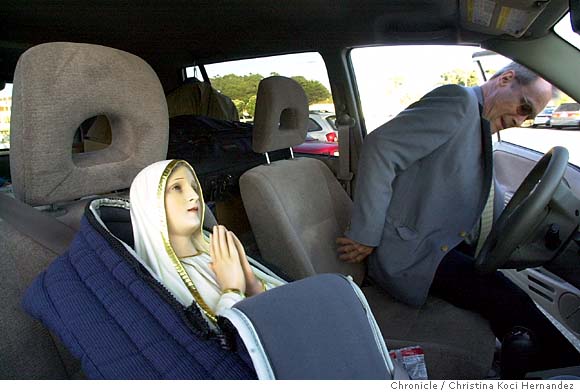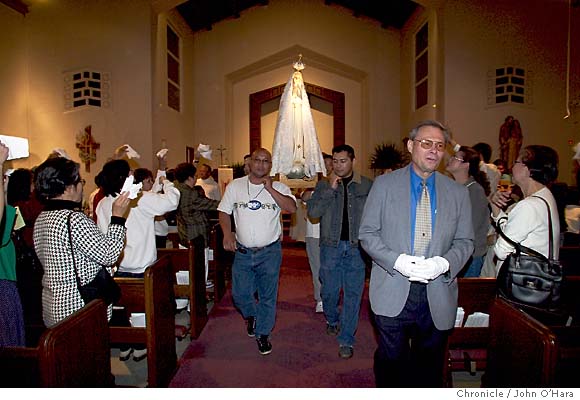Carl Malburg wanders the world with a statue in tow
The 40-inch Mary he travels with has been venerated by 100 million people. That spells many miles, and, he says, many miracles.After all the years and all the parishes, all the grateful hugs, the tearful confidences, the fervent pleas for special prayers -- all the miracles -- Carl Malburg still believes that he's not the best man for the job.
"When people ask me to say prayers for them, I often say, 'If you knew me you'd be asking someone else to pray for you,' " he says. "I am very ordinary."
Possibly, but his job isn't. Malburg, 63, is the official custodian of the International Pilgrim Virgin Statue of Our Lady of Fatima, a 40-inch-tall, carved mahogany Mary, as she is said to have appeared to three shepherd children in Fatima, Portugal, in 1917.
Appeared, that is, with two exceptions: a 7-inch gold crown and white satin cape that adorn the statue these days when it is shown.
"Neither a cape nor a crown was at Fatima, but we always display it that way because we want to give Mary more honor," says Malburg. "She is a queen. But at Fatima she came as a mother, in a simple white dress."
Being the Pilgrim Virgin statue's keeper means that Malburg is on the road for three weeks a month, for 11 months of every year. This Christmas will find him in India. A Michigan native who now lives in Munster, Ind. (when he's home), Malburg drives if the journey is less than 1,000 miles and flies if it's more than.
The statue rides shotgun in his car -- in a seat belt -- and in the seat next to him on planes.
"Once in a while one of the airlines will put us in first class, but that's usually in a foreign country where the people are all Catholic," he says.
Wherever the statue goes, Malburg also packs display lights and dozens of boxes crammed with pamphlets, rosaries and brown scapulars --
symbols of devotion and protection since 1251, when St. Simon Stock said the Holy Mother first pressed a scapular into his hands.
On a foundation's shoestring budget, Malburg's lodgings are nearly always in a rectory or parishioner's home. And he's been at it for more than 10 years.
"I'm a traveler, a wanderer," he says, then adds with a little grin, "They call me a roamin' Catholic."
Malburg and the Fatima statue just ended a three-week, 23-parish journey around the San Francisco Archdiocese. The trip commenced with a special Mass on Sept. 1 at Our Lady of Mt. Carmel in Mill Valley and concluded last Sunday at St. Isabella Church in San Rafael.
"Since it was carved in 1947, more than 100 million people have venerated that statue," Malburg says, taking a break in the sun from his duties inside St. Cecilia Church in San Francisco. "It's why we have to have a sign that says, 'Please do not touch her, she will touch you.' "
To many non-Catholics, Virgin Mary sightings are right up there with UFOs and alien abduction stories. But to the world's 1 billion practicing Roman Catholics, places like Lourdes in France, Medjugorje in Bosnia-Herzegovina, Guadalupe in Mexico and Fatima are where the mother of Jesus appeared, spoke of peace and penance, worked miracles and continues to work them. Pope John Paul II has credited Our Lady of Fatima for allowing him to survive an attempted assassination.
Millions of faithful travel each year to Portugal and the once-humble site of the 1917 series of six apparitions. Tens of thousands belong to Fatima societies, such as the Blue Army, and pray to replicas of Fatima in their own churches. Two of the shepherd children, Jacinta and Francisco Marto, died in childhood -- as the Virgin said they would -- and were beatified by the church in 2000. The third, Lucia dos Santos, became a Carmelite nun. She is 93 and cloistered in Portugal.
It was Sister Lucia's description of Mary that Portuguese sculptor Jose Thedim used to carve two statues in 1947: one to travel east through Russia, one to go west. The eastern version now spends most of its time in Fatima; the western version has been on the move since its creation.
"People ask me, 'Where does the statue stay?' " says Malburg. "It stays on the road. It doesn't have a home."
On the rare occasions when Malburg is back in Munster, the Fatima statue stays in a Chicago monastery, a Hammond, Ind., nursing home or at Malburg's house: "My wife has fixed a nice place for it in our living room."
But the nice place is not an altar. The crown and cape remain packed, and Malburg and his wife say their nightly prayers as usual, in their bedroom, not in front of the statue.
That Malburg should have a wife at all might seem something of a miracle in itself, what with his travel schedule and all. His predecessor, retired by illness, was a lifelong bachelor. All custodians before that were priests.
Fortunately though, Rose Marie Malburg was "quite dedicated to Fatima things" long before she married Malburg nine years ago. She runs http://www.pilgrimvirginstatue.com/, edits the foundation newsletter and makes a few trips a year that don't require her to live out of suitcase for too long.
"I had this job a year before we became engaged," says Malburg. "She knew what she was marrying -- a wanderer."
Besides, when her husband does come home, Rose Marie gets to hear about "all the little miracles" that occurred on his journey.
"The church wants us to be careful using that word, miracle," he says. "They officially recognize only a couple a year, but there are probably 1,200 that you and I might see."
In the Fatima statue's 56-year existence, there have been several documented and photographed reports of it shedding tears. People have seen its tiny, rosebud mouth smile, its extraordinary brown glass eyes follow theirs.
Meanwhile, Malburg has lost count of the women and men who have prayed to the statue and been cured of all manner of malady. Cancer, alcoholism, drug addiction, suicidal depression, wayward spouses, grief over an abortion, loss of faith in God.
"Usually, it's spiritual things like the cure of alcoholism, but occasionally we have a physical cure, and it's quite astounding," he says. Describing two incidents -- a man whose incurable cancer disappeared and a young woman who'd fallen away from the church but came back after 17 years -- Malburg ranks the latter above the former: "God does not interfere with our free will, so the conversion of a sinner is most significant. The guy who was cured of cancer, 20 years from now, he'll be dead of something else. But that young lady's conversion, that miracle will last for eternity."
For all his self-deprecating jokes, when Malburg tells those kinds of stories, a quiet, grateful wonder creeps into his voice and onto his face. Before he accompanied Our Lady all over the Western Hemisphere, he was raised on a timber farm and worked as a lumberjack for 20 years.
So, unlike his predecessors he does not call his mahogany companion "she." So? His relationship with and devotion to the woman the statue honors are obviously deep and rich.
After more than a decade, after hundreds of setups and take- downs, hundreds of historical talks to grade-schoolers and senior citizens, hundreds of intimate confidences and joyous accounts of comfort and deliverance, Malburg seems as open and obedient as the three shepherd children.
"This is very exciting work," he says. "Every day is different, yet every day we expect some kind of marvels. One day, when it might seem to get mundane,
I'll hear a report of someone who's been helped, and suddenly I'm full of thrills again, and wondering what's around the next corner."

